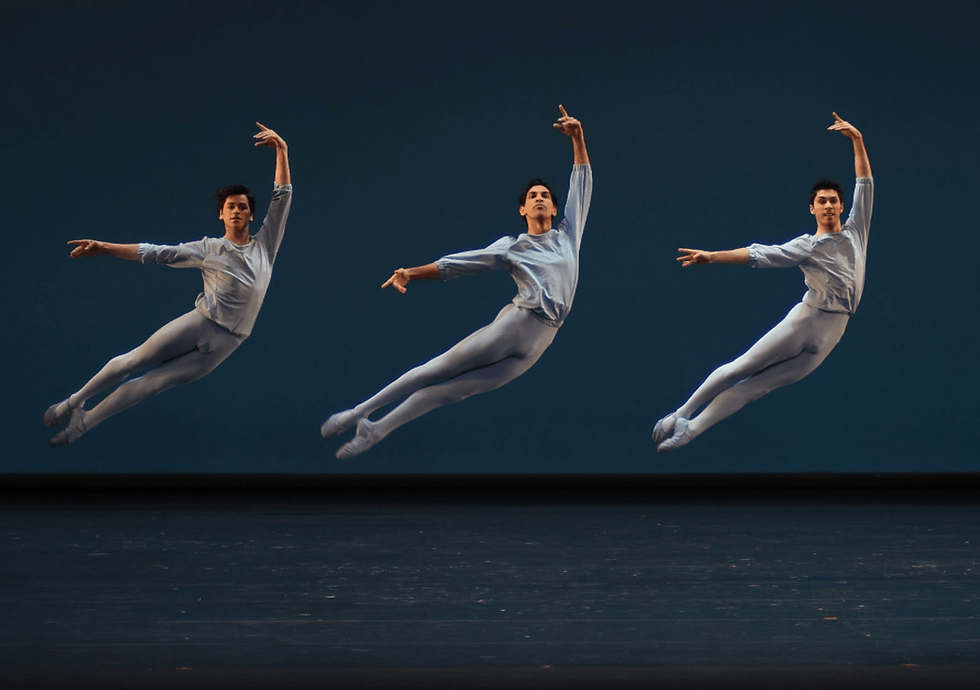[ENG] Hong Kong Arts Festival
- Kevin Ng
- Apr 10, 2017
- 4 min read

Allegro Brillante, Choreographer: George Balanchine; Dancers: Carl van Godtsenhoven, Flemming Puthenpurayil, Francesco Leonep
Photo: Charles Tandy
This year’s Hong Kong Arts Festival opened with a ballet program – La Bayadere performed by Germany’s Bayerisches Staaatsballett (Bavarian State Ballet), which was making its debut here. La Bayadere (The Temple Dancer), a 19th century classic, is a good choice for local audiences, as it hadn’t been performed here for over a decade.
This lavish 1998 production by the former Paris Opera ballet master Patrice Bart is more or less faithful to Petipa’s original choreography. Set in Raj India, this story of intrigue, jealousy, and divine retribution has plenty of exotic dancing to delight the audiences. The tom-tom drum dance is explosive, contrasted by the graceful Djampe dance for six female dancers holding scarves.
The most famous episode of this classic is the Kingdom of the Shades scene, in Act 2 of this production. This ‘ballet blanc’ is a touchstone of classical ballet. The two final scenes – the wedding in the temple, and the apotheosis – are Bart’s own choreography, since Petipa’s original choreography has been lost.
The temple scene fortunately includes an exciting virtuoso solo by the Golden Idol, and the final destruction of the temple is quite theatrically depicted by red fabric. The apotheosis, however, which sees the three leads marching together with their backs facing us, is bewildering. In view of the loss of choreography in the final act, it would have been far better for the whole ballet to end with the glorious Kingdom of the Shades scene, as in the Mariinsky Ballet’s version, instead of substituting new choreography for the two final scenes.
The Bavarian State Ballet, based in Munich and now directed by the former Mariinsky star Igor Zelensky, is a good second-tier company, though at present relatively weak in terms of principals. In the Saturday night performance, the dancers in the lead roles were generally good but not particularly exceptional. As Nikiya, Ivy Amista was at her best in the Kingdom of the Shades scene with her dazzling virtuosity.
As her love rival Gamzatti, Prisca Zeisel was quite glamorous but lacked technical strength. She fell off her series of fouette turns half-way through in the coda of the grand pas in Act 1. Erik Murzagaliyev, a soloist from Kazakhstan, was muted as the heroic warrior Solor. His technical virtuosity lacked brilliance.

La Bayadere, Choreographers: Marius Petipa and Patrice Bart; Dancer: Ivy Amista, Osiel Gouneo
Photo: Wilfried Hösl
The Bavarian company’s corps de ballet impressed in the Kingdom of the Shades scene. Among the three shades soloists, the second one (Elizaveta Kruteleva) was the best and got the loudest applause. In Act 1, the divertissements were well danced despite the cramped stage of the Cultural Centre; and the two love rivals’ confrontation scene was dramatic.
A few nights later, the small second junior company, the Bavarian State Ballet II, presented a mixed program of four ballets. It’s a long and tedious evening set to taped music. The taped music sounded awful in the first half. It spoilt the opening work, Balanchine’s 1956 miniature masterpiece Allegro Brillante. The lead woman Bianca Teixeira evidently struggled with the technical virtuosity, and tried to cover up with her bright smiles. I must say that Hong Kong Ballet danced this piece far better in past seasons.
Jardi Tancat, the second work, an early piece by Spanish choreographer Nacho Duato set to Catalan folk songs, was danced by three couples. The style was very dated, and in the same vein as Jiri Kylian. The couples represented a village community that seemed to be in grief and mourning. The solos were mournful. This was followed by a slight and trivial work set to Gershwin entitled Three Preludes by German choreographer Richard Siegal that was average.
The last piece The Triadic Ballet dragged on for far too long, lasting 70 minutes. Being a historic work by the Bauhaus period German choreographer Oskar Schlemmer, it was perhaps worth us seeing it once. But one viewing is enough. The whole work is more like a fashion show in an art gallery and the choreography is not particularly interesting or inspired. It would have been far better if the main Bavarian company had also given a second program after La Bayadere, instead of the Arts Festival flying in this Bavarian State Ballet II that was at the standard of a school performance.
Fortunately, that second week of the Arts Festival was redeemed by a performance of the nine-strong New York tap dance company named Dorrance Dance and directed by Michelle Dorrance. Their two-part show ETM: Double Down was most enjoyable and life enhancing. The first half was more allegro, while the numbers in the beginning of Act 2 were more lyrical. It reminds me of the Irish troupe Fabulous Beast Dance Theatre that appeared in the 2014 Arts Festival. The Dorrance dancers’ rhythmic subtlety was a constant delight, and conveyed in the simplest of means.
===
Kevin Ng
started reviewing dance in 1997. He has contributed to many publications including The Financial Times, Wall Street Journal Asia, Hong Kong Economic Journal, Time Out Hong Kong, Moscow Times, Ballet Review (New York) and Ballet 2000 (Italy).
La Bayadere Choreographers: Marius Petipa and Patrice Bart
Performance: 18 Feb 2017 19:30 Grand Theatre, Hong Kong Cultural Centre
Bayerisches Staatsballett II (Bavarian State Ballet II) Mixed Bill Choreographers: George Balanchine, Nacho Duato, Richard Siegal, Oskar Schlemmer, Gerhard Bohner Performance: 21 Feb 2017 19:30 Lyric Theatre, HKAPA
ETM: Double Down Choreographers: Michelle Dorrance and Nicholas Van Young Performance: 24 Feb 2017 20:00 Lyric Theatre, HKAPA





Comments